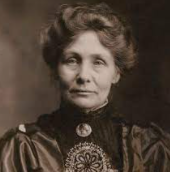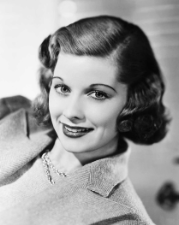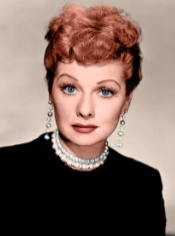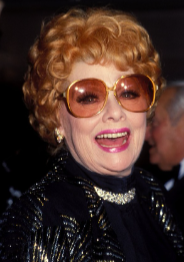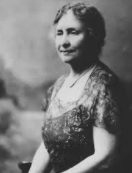“One of the things I learned the hard way was that it doesn’t pay to get discouraged. Keeping busy and making optimism a way of life can restore your faith in yourself.” -Lucy.
Written by: Amber Baldwin
Lucille Ball was an actress and comedian best known for her role as Lucy Ricardo in the tv show I Love Lucy. She also helped pave the way for female comedians and CEOs by never giving up and believing in herself. She also worked incredibly hard with everything she did.
Lucille Désirée Ball was born on August 6, 1911, in Jamestown, New York, to Henry Durrell Ball and Evelyn “DeDe” Ball. When Lucille Ball was three, her father passed away from typhoid fever. Her mother married Edward Peterson four years later. He suggested that Lucille Ball audition for a chorus line when she was twelve. During the audition, Ball decided that she wanted to be an actress. Then, when she was a teenager, she attended the John Murray Anderson School for Dramatic Arts in New York City. However, her teachers thought she was not good enough and told her she wasted her time and money.
This did not discourage her. In 1928 she became a model for Hattie Carnegie. But her modeling days soon ended when she came down with rheumatic fever and could not walk for two years.
Her illness did not discourage her, and in 1932 she went back to New York City to continue to work as a model and audition for Broadway.
Ball’s modeling work as Chesterfield Girl led to her first movie role as a Goldwyn Girl in Roman Scandals (1933).
This movie took Lucille Ball to Hollywood, where she decided to stay after filming to keep playing minor roles in other movies. By the late 1930’s she was receiving more prominent roles and became known as the “Queen of the B Movies.”
In 1940 Lucille Ball starred in the picture Too Many Girls with Cuban bandleader and actor Desi Arnaz. The two started dating and were later married that same year.
Since Arnaz traveled with his band while Ball made movies and radio shows, they did not get together that much. When CBS wanted to take the radio show Lucille Ball was in and turn it into a TV show, she agreed to do it, but only if Desi Arnaz could play her husband in the show.
People at CBS did not think it was a good idea to show an American and a Cuban married to each other. So, Ball and Arnaz created a vaudeville act that traveled the country and formed their own production company called Desilu. They filmed a pilot episode to convince CBS to let them do the show.
After this, CBS finally agreed to let them do the show. I Love Lucy ran from 1951 to 1957. It was followed by the Lucy-Desi Comedy Hour, which ran from 1957 to 1960. Arnaz and Ball were the power couple of the 1950s.
In 1960 Lucille Ball and Desi Arnaz divorced, but they still owned Desilu together. Desilu was responsible for TV shows such as The Andy Griffith Show, The Dick Van Dyke Show, My Three Sons, Star Trek (she was the only one who would risk taking on the show, so without Lucy, there would be no Star Trek), Mission: Impossible, and The Lucy Show. The Lucy Show, of course, starred Lucille Ball, and it ran from 1962 to 1968.
Desi Arnaz also sold his shares of Desilu to Lucille Ball in 1962. This made her the first woman to be a major production studio president and CEO. She sold Desilu in 1968 to Gulf+Western, known today as Paramount Television.
From 1968 to 1974, Lucille Ball performed on the TV show Here’s Lucy with her children Lucie Arnaz and Desi Arnaz Jr.
During the 1970’s she also was the lead in the movie Mame, performed in television specials, made many guest appearances on other TV shows, and became an assistant professor at California State University, Northridge.
Lucille Ball starred in her last TV show, Life with Lucy, in 1986. On April 26, 1989, she passed away from a ruptured abdominal aortic aneurysm.
Throughout her life, Lucille Ball received many awards and honors, including five Primetime Emmy Awards, two stars on the Hollywood Walk of Fame, an International Radio and Television Society Gold Medal in 1971, Female Star of the Year in 1973, a Crystal Award in 1977, the Cecil B. DeMille Award in 1979, Lifetime Achievement Award from the Kennedy Center Honors in 1986, the Lifetime Achievement Award in Comedy in 1987, and Woman of the Year in 1988.
Even after her death, Lucille Ball is still being recognized and celebrated. She has received awards and honors such as the Career Achievement Award in 1989, the Presidential Medal of Freedom in 1989, the Desert Palm Achievement Award in 1990, and the Legacy of Laughter Award in 2007. She was also inducted into the Television Hall of Fame in 1997 and the National Women’s Hall of Fame in 2001.
In Lucille Ball’s hometown of Jamestown, NY, there is the Lucy-Desi Museum and the National Comedy Center. Every year during the week of her birthday, her hometown also has a comedy festival.
In 2021, a movie was made that takes place during one week of production of I Love Lucy called Being the Ricardo’s. Nicole Kidman plays Lucille Ball, which can be found on Amazon Prime Video.
Ball was also a recent star of the month on the Turner Classic Movie or TCM channel. TCM also has a podcast called The Plot Thickens, and their most recent season focuses on telling her life story. A new documentary called Lucy and Desi is coming to Amazon Prime Video on March 4. It is directed by Amy Poehler.



